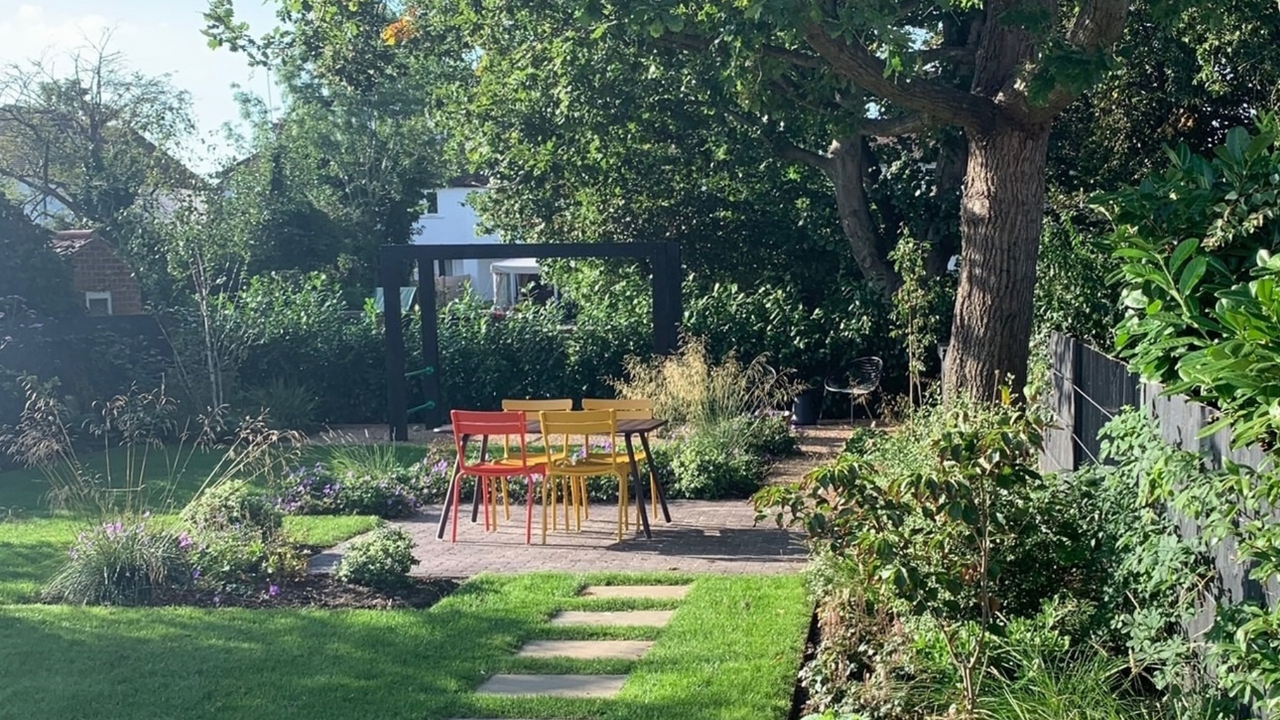Terka Acton, Interview with a Garden Designer
Nov 07, 2022
Ellora: Hi Terka, We have chatted a few times over the years but sadly not had the chance to work together yet on projects. I instantly connected with your approach to garden design and planting and am very grateful for the opportunity to interview you and have you as one of our female professionals within the group.
Terka: Hi Ellora, thank you for having me!

1. So tell us a bit about you, how did you start your career, what types of projects do you work on?
As with many garden designers, this is a second career for me: after twenty happy years in publishing, I retrained at Capel Manor College and launched my business in 2015.
The freedom of being my own boss is wonderful. I love collaborating with people on their gardens, and find the creative, varied nature of this profession hugely satisfying. Most of my projects are domestic spaces in and around London, although I have also worked on public sphere projects, and collaborated with architects and developers on commercial sites. I’ve learned to trust my instincts when it comes to choosing projects – it’s important to connect with both the clients and the space, and budget is not the only consideration.
2. You said to me once that “viewing the garden and house as a whole is so important” for those undertaking renovation projects, can you tell us a bit more?
For me, gardens must be designed in their context – and the house is central to that. The geometry of the garden always relates back to the house. This does not limit the possibilities available to you as a client or designer, it just means that there needs to be a conversation between the house and garden for the project to really succeed.
3. Is there any typical guidance on what people should spend on their front versus back garden or on what they should prioritise if they can only afford to do work in stages?
I think this comes down to personal preference, although my experience is that people tend to prioritise back gardens both in terms of timing, and when it comes to allocating budget.
4. My garden is a bit wild at the moment (due to laziness too), we grow veg and have a kind of meadow at the front, but I like order too a place to sit and kids to play. Where do people start when planning the design of a garden with you?
It sounds like your garden works perfectly for you right now! And that’s where I always start: what do you want from the garden, and how can we make it work for you? If you get to know your garden and its natural resources and characteristics, you can save time and money as well as create a space that works well both for you and for nature. How many people do you like to entertain? Do you want to grow food? Encourage wildlife? If children will use the garden, what do they want to include? Remember that elements can serve a dual purpose: I recently designed a pergola with integrated climbing bars that are invisible when viewed from the house. It’s also important to consider the practicalities of what you will need in terms of storage, compost and utility areas. Once you know what you want to use the garden for, you can think about which areas to allocate for what purposes, and how to make the spaces work for you.
5. What are the general stages you go through with a client when designing a garden with them?
Taking the brief is the first step: listening to what the client wants from their garden is the most important thing. Next I spend time on site: for large or complex gardens a specialist topographical survey may be required, but I always carry out the site analysis myself to get a real feel for the garden and its environs. The next stage is to develop an outline design that reflects the brief and builds on the survey and site analysis. This outline design is then refined with the client into the detailed design: this comprises the presentation plan the landscaper will work from, along with any additional drawings, and the planting plan.
6. What type of team do you work with and how does that vary from project to project?
I often work with architects and interior designers as well as their clients on the development of the design. When it comes to the build, I typically put forward several landscapers I’ve worked with for the clients to consider. This works especially well given the range of budgets involved – the gardens I design can cost from around 20K to over 80K to build, and different landscapers will be the best fit for different projects. I meet with the client’s chosen landscaper for a setting-out meeting as the build gets underway, and clients then typically engage me to stay connected with the project during the build, and then come back in to plant it up.
7. What climate change, wildlife and sustainability issues are paramount for people now to think about when you design their garden?
Building a garden, like renovating a house, does consume materials and energy, but we can minimise this by reusing materials such as paving where possible, and designing in existing mature plants.
Looking after the soil is crucial: all soil benefits from regular mulching with organic matter, and when you feed the soil in this way you are making water and nutrients more available to the plants, as well as limiting evaporation and minimising weeds. Healthy soil results in healthy plants that are more resilient to the extremes of climate change.
We do need to reassess plant choices in view of the more extreme temperatures we’re experiencing: ideally plants need to be frost-and drought-resistant, and able to cope with sporadic water-logging. In a sustainable garden, the aim is to create plant communities that work together to offer year-round structure, colour, texture and scent, as well as habitats, forage and water for wildlife. We can help wildlife by not being overly tidy: leaving seed heads standing over winter provides valuable food and shelter for pollinators, and piles of logs and leaves are ideal for shelter. Clients are increasingly interested in working with the environment in this way, and my designs often include wildflowers areas, compost bays and edible planting.
8. With the recent heatwaves across the UK are there changes we can make to our gardens that can help cool our houses or cool the ambient temperature around our homes?
One of the best things to cool your house is create shade: plant trees, and plant up as much of the garden as possible, including green roofs, climbers on walls, fences and pergolas, and ground cover plants to help cool the soil. Cover any bare soil with a mulch of garden compost or composted bark. Avoid artificial grass – it heats up more than natural grass, as well as damaging the soil beneath, and is not recyclable.
Reducing hard landscaping can help to keep spaces cooler by reducing the heat sink effect: I often specify stepping stones rather than paths, and areas of permeable paving - such as stabilised gravel or clay pavers - that allow rainwater to soak into the garden, cooling the soil and making water available to plants. Where there are areas of impermeable paving, it’s useful to lay them so that the rainwater runs off into planting beds: this keeps planting lush and reduces the risk of flash flooding.
9. I don’t want to forget those who don’t have the fortune of owning a garden but possibly have a terrace or small balcony, are there any recommendations you have for people to think about when designing a pocket garden in such a space?
Terraces and balconies are great fun to design, and elements like folding furniture and outdoor rugs can help maximise these areas. It’s especially important to relate the materials you use in these outside areas to those inside, and use a similar colour palette, to unify the spaces. Just make sure that the space can take the weight: check this with a structural engineer. Soil is heavy: to reduce weight, planters can be filled with a lightweight medium like leca and then a top layer of soil.
In terms of plants, lavender, ornamental grasses and many herbs are adapted to hot, dry exposed sites. Combine trailing and mounding plants for a relaxed, natural look: Pittosporum tobira and Pinus mugo are both great evergreen structural plants for creating privacy in exposed environments, and Erigeron karvinskianus is a tough trailing plant with irresistible little white daisy-like flowers fringed with pink. Don’t forget edibles – many can be grown in pots. And go large with your planters: big planters have more visual impact, and also dry out more slowly than lots of little pots. Consider a drip irrigation system on a timer. Finally, lighting is key: I love uplighting large plants for subtle drama and impact that doesn’t add unduly to light pollution.
10. How do you believe garden design is going change over the next 10-20yrs and what do you believe are the biggest challenges?
We’re already seeing challenges due to climate change, and these are likely to be our biggest challenges. The good news is that clients and colleagues are increasingly open to conversations around this, covering everything from working with sustainable materials to choosing plants that have evolved to cope with more extreme conditions. It’s all about looking after our green spaces – and if we do so, they can continue to look after us.
Please feel free to contact Terka if you would like to discuss any upcoming projects you have.

